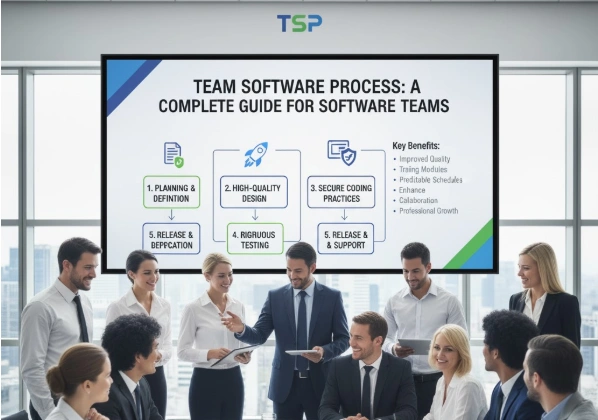In the world of software development, it’s not just what you build that matters—it’s how your team builds it. The Team Software Process (TSP) offers a disciplined, metrics-driven framework that helps software teams deliver higher quality, improved predictability, and stronger collaboration. This article will walk you through what TSP is and where it came from, core principles and process steps, benefits and challenges, how to implement TSP in your organization, real-world tips and insights, and a recap with next steps. Let’s get started.
1. Origins and Definition of TSP
1.1 The genesis of TSP
TSP was conceived by Watts S. Humphrey at the Software Engineering Institute (SEI) in the 1990s as a way to bring structure and measurement to team-based development. It is an extension of the Personal Software Process (PSP) concept, which focuses on individual engineers’ discipline and measurement practices. While PSP addresses how a single developer plans, tracks, and improves their personal work, TSP scales those principles to the team level. The goal? A skilled, self-managing team with clear metrics, roles, and continuous improvement.
1.2 What is the Team Software Process?
At its heart, TSP is a team-based software engineering methodology centered on defined processes, data-driven decisions, and continuous quality improvement. Unlike ad-hoc or loosely disciplined workflows, TSP provides a structured framework — from planning and estimation to testing, integration, and retrospectives. Its primary aims are improving software quality, increasing predictability and productivity, reducing project risk, and cultivating higher team morale and accountability. When properly adopted, TSP can transform how teams work: less firefighting, more foresight.
2. Key Principles Underpinning TSP
To truly grasp how TSP works, it helps to understand its foundational principles. These guide not just “what to do” but “why you do it.”
2.1 Team as the unit of execution
Rather than focusing on individuals, TSP treats the team as the principal entity. Decisions, planning, and performance tracking all happen at the team level. Every team member understands how their work integrates into the whole.
2.2 Process definition and discipline
TSP demands that teams explicitly define their software process—step by step—and then follow it rigorously. This eliminates ambiguity and variability that often plague software projects.
2.3 Measurement drives insight
One of TSP’s signature features is the collection and use of metrics. Teams track data points like defect rates, effort per task, schedule slips, test coverage, and more. Those numbers guide decisions and process improvements.
2.4 Continuous process improvement
There’s no “one-size-fits-all” in TSP. After each project or cycle, teams conduct a postmortem to identify what went right and wrong. Lessons learned feed into refined processes for next time.
2.5 Emphasis on quality throughout
Rather than treating testing as a final phase, quality is baked into every stage—design, code reviews, unit testing, and beyond. Every team member takes ownership of minimizing defects.
3. The Seven Core Phases of TSP
TSP is structured into seven sequential, yet partly overlapping, phases. Below is an adapted breakdown to suit modern software contexts.
| Phase | Purpose | Key Activities |
|---|---|---|
| Launch | Kick off and alignment | Define goals, scope, roles, risks, and schedule |
| High-Level Design | Architecture & component planning | Identify system modules, interfaces, and major data flows |
| Implementation (Coding & Unit Test) | Code development | Developers code, review, test their components |
| Integration | Build and assemble modules | Combine components, resolve integration defects |
| System Testing | Validate the overall system | Execute system-level tests, performance tests, etc. |
| Postmortem (Lessons Learned) | Reflect on what happened | Analyze metrics, root causes, and successes |
| Process Improvement | Evolve the team’s processes | Apply lessons to refine and evolve the process for next cycle |
3.1 Launch
This is where the team aligns on mission, scope, schedule, roles, and risks. A kickoff workshop brings everyone onto the same page. Typical outputs include project goals and success criteria, work breakdown structure (WBS), risk register, and initial schedule and resource plan.
3.2 High-Level Design
In this phase, the team defines the core architecture and subsystem decomposition. Key design decisions are made here, such as identifying major components, defining interfaces and communication paths, choosing high-level algorithms or patterns, and estimating effort and dependencies.
3.3 Implementation (Coding & Unit Testing)
Each engineer codes to the design, but with strong emphasis on early testing and code reviews. TSP promotes personal test plans, peer code reviews, tracking of defects (source, fix time, severity), and recording effort and time per task.
3.4 Integration
Once modules are ready, the team integrates them into a combined system. This is where many defects surface. Activities include merging and building components, running integration tests, logging defects and analyzing root causes, and adjusting schedules based on findings.
3.5 System Testing
After integration, the full system undergoes end-to-end validation: functional tests, performance tests, user acceptance tests, and more. The team continues to capture defects and metrics.
3.6 Postmortem (Lessons Learned)
Once the project or release cycle completes, the team gathers for a candid review. They compare actual vs. planned metrics, list successes, failures, surprises, identify root causes of problems, and document improvement ideas.
3.7 Process Improvement
The most vital final step: updating the team’s process definition. Changes might include adjusting phase durations, tweaking defect review practices, revising estimation models, and removing redundant tasks. Then the cycle restarts, with the next project incorporating these refinements.
4. Benefits of Adopting Team Software Process

Implementing TSP is a serious commitment, but it can yield substantial gains. Below are some of the proven benefits, with contextual nuance and examples.
4.1 Stronger software quality
Because TSP embeds quality at every stage, fewer defects escape to production. Teams monitor defect density, fix rates, and defect leak rates to proactively manage risk. Example: A team adopting TSP reduced their post-release defects by over 50% within two cycles by catching integration issues earlier.
4.2 Better predictability and schedule control
With disciplined estimates and frequent tracking, teams can more reliably forecast their delivery timelines. Predictability is a key selling point to stakeholders.
4.3 Higher productivity / less wasted work
By catching defects early and reducing rework, teams can spend more time on delivering features. The feedback loops in TSP prevent time being eaten by firefighting.
4.4 Cost savings and resource efficiency
Less rework, fewer defects, and better estimation translate to lower costs. Combined with code reuse and efficient practices, TSP can yield meaningful savings.
4.5 Greater team morale and cohesion
TSP’s role clarity, shared responsibility, and predictable cadence lead to a healthier team culture. When people see progress and feel ownership, morale improves.
4.6 Lower risk of project failure
Teams are more capable of identifying and mitigating risks early. With ongoing measurement and review, surprises are less likely to derail the project.
5. TSP vs. Agile: Can They Coexist?
You might wonder: “Is TSP at odds with Agile, or are they mutually exclusive?” The good news: they can complement each other.
5.1 Differences and tensions
TSP is more disciplined and plan-driven, with strong emphasis on measurement and formal reviews. Agile emphasizes adaptability, minimal documentation, and embracing change. The tension lies in rigidity vs. flexibility.
5.2 How to blend them
Many teams adopt a hybrid approach: use TSP’s measurement, defect tracking, and postmortems within Agile sprints; keep Agile’s short feedback loops and incremental delivery, but overlay disciplined planning and quality metrics; use TSP-style estimation and tracking in sprint planning; perform mini postmortems at the end of each sprint (so process improvement stays continuous). When done well, this fusion yields more predictable, high-quality Agile outcomes.
6. How to Introduce TSP in Your Organization

Switching to TSP is a journey, not a flip-switch. Here’s a pragmatic roadmap.
6.1 Step 1: Audit your current process
Begin with a candid assessment: document your existing development workflow, identify bottlenecks, common failure points, and waste, solicit feedback from team members, and examine defect trends, velocity variability, and rework rates. This baseline will help you measure impact later.
6.2 Step 2: Craft a phased adoption plan
You don’t need to adopt everything at once. Set clear objectives (e.g. reduce defects by 30%, improve schedule accuracy), choose initial TSP practices to pilot, build a rollout timeline accounting for learning curves, and allocate training, coaching, and tools.
6.3 Step 3: Train your team
Training is vital. Explain TSP principles, metrics, and roles; provide templates, scripts, and tracking tools; run a workshop or bootcamp with hands-on simulation; emphasize the “why” behind each practice so teams internalize them.
6.4 Step 4: Pilot with a small project
Pick a low-risk project or a module to trial TSP. Advantages: lower stakes, fewer consequences of mistakes, real environment to test TSP without full exposure, and internal success stories for inspiration.
6.5 Step 5: Monitor, measure, and adjust
Continuously collect metrics (defects, effort, schedule variance), compare actuals to estimates, conduct regular reviews and process fine-tuning, and use the feedback loop to refine practices.
6.6 Step 6: Scale across the organization
Once the pilot is proven: share success stories, train more teams, promote TSP as a cultural norm, and adjust as complexity grows.
7. Common Challenges and How to Overcome Them
Every effort to improve methodology meets friction. Here are typical challenges in TSP adoption—and how to tackle them.
7.1 Resistance to change
People naturally resist changing habits. Solution: Start with strong executive sponsorship. Communicate clear benefits, show data, and provide support. Use champions and early adopters to influence others.
7.2 Overhead perception
Teams often view measurement, reviews, and data collection as overhead. Solution: Start lightweight. Prove value early—show how metrics lead to fewer defects and less rework. Gradually increase the rigor as teams appreciate the return.
7.3 Lack of consistent discipline
Processes can backslide under pressure. Solution: Bake discipline into the culture. Hold teams accountable, review adherence regularly, and insist on postmortems and metrics, even when busy.
7.4 Misuse or misinterpretation of metrics
Data without context can mislead. Solution: Educate the team in how to read metrics. Use them for insight, not blame. Always pair metrics with root cause analysis and qualitative feedback.
7.5 Scaling in distributed teams
Geographically separated teams complicate coordination. Solution: Use collaborative tools, enforce clear communication protocols, schedule synchronized reviews, and maintain strong process alignment across locations.
8. Practical Tips & Best Practices
Use automated tooling to collect effort and defect data (to reduce manual burden), visualize metrics via dashboards so the team sees trends, run short “process health checks” mid-project, reward not just feature delivery but process adherence, rotate roles to spread the experience, maintain a lessons-repository for new teams, encourage psychological safety for open discussion, and compare projected vs. actual data often.
9. Illustrative Example (Hypothetical Use Case)
Imagine a mid-sized software product team at a fintech startup. They had recurring production defects, schedule overrun, and low team morale. They chose a three-month module development as a pilot for Team Software Process. Here’s how they applied it: Launch: defined goals; Design: outlined module boundaries; Implementation: wrote code, peer-reviewed, and logged defects; Integration & Testing: fixed issues and adjusted timelines; Postmortem: compared planned vs. actual metrics; Process Improvement: improved estimation and onboarding. The pilot cut defects, improved delivery, and raised morale—encouraging wider adoption.
10. Integrating With Content from softnexushub.site
To deepen understanding, you may refer to related content on softnexushub.site, such as the article about “what is 493xds5-0 in software”. That piece delves into internal versioning metadata, and by cross-referencing it, you can explore how TSP teams might manage version identifiers, code component metadata, and traceability strategies in robust software development. (You can read more here: What is 493xds5-0 in software). This internal linking also helps reinforce your site’s authority to search crawlers.
11. Conclusion & Next Steps
The Team Software Process is not a silver bullet—but when implemented with discipline, thoughtful calibration, and team buy-in, it can transform how your organization delivers software. By blending structured planning, relentless measurement, and continuous process evolution, TSP helps teams reduce defects, improve predictability, and foster a culture of accountability. If you decide to move forward: conduct a baseline audit, pilot TSP practices, monitor metrics, and scale gradually. Explore more resources on softnexushub.site for related engineering insights. Adopt TSP thoughtfully—not rigidly. Let metrics guide your evolution, not constrain your creativity. “Process improves when people improve; metrics illuminate where to grow.”
FAQs
Q1: Is TSP only suitable for large organizations or enterprise projects?
Not at all. It scales well but can also fit small teams if introduced gradually.
Q2: How long does it take to see benefits?
Teams usually see measurable gains after one or two project cycles, with greater improvements over time.
Q3: Can TSP slow development?
Initially yes, but the reduced rework and improved predictability later result in faster, cleaner delivery.
Q4: What metrics should a TSP team track?
Defect density, schedule variance, fix times, and effort per task are fundamental metrics.
Q5: Does TSP replace Agile?
No. It complements Agile by adding structure and measurement to iterative development.

